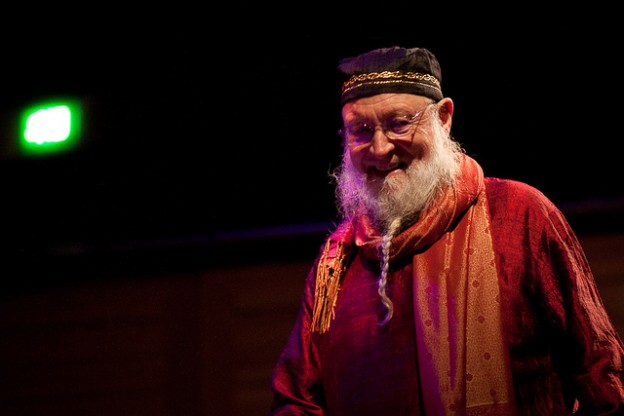
John Adams has described Phrygian Gates and its shorter “companion” piece China Gates (written between 1977 and 1978) as his “Opus 1.” Built on an unrelenting sense of pulse and unfolding gradually, both pieces were influenced by the Minimalism of Terry Riley (In C), Steve Reich, and Philip Glass. Process (like phasing and gradually building musical patterns with the addition of one note at a time) lies at the heart of early Minimalism. Phrygian Gates and China Gates may be Adams’ most process-oriented works, but there’s also a sense of restlessness. John Adams was once described as “a Minimalist bored with Minimalism.” Even in these first mature works, written around the time Adams turned 30, unexpected disruption of process foreshadows Adams’ later music.
At his blog, Earbox, John Adams describes Phrygian Gates:
Phrygian Gates is a 22-minute tour of half of the cycle of keys, modulating by the circle of fifths rather than stepwise à la Well-Tempered Clavier. The structure is in the form of a modulating square wave with one state in the Lydian mode and the other in the Phrygian mode. As the piece progresses the amount of time spent in the Lydian gradually shortens while that given over to the Phrygian lengthens. Hence the very first section, on A Lydian, is the longest in the piece and is followed by a very short passage on A Phrygian. In the next pair (E Lydian and Phrygian) the Lydian section is slightly shorter while its Phrygian mate is proportionally longer, and so on until the tables are turned. Then follows a coda in which the modes are rapidly mixed, one after the other. “Gates,” a term borrowed from electronics, are the moments when the modes abruptly and without warning shift. There is “mode” in this music, but there is no “modulation”.
The Phrygian and Lydian modes, commonly used in jazz, with roots back to ancient Greece, have a distinctly different sound and “feel” from major and minor scales. (Listen to the sound of the Phrygian and Lydian modes). These scales seem to float in midair because they don’t have the same sense of pull from dominant to tonic we hear in tonal music. In an interview with Edward Strickland, John Adams described the qualities of these modes and their relationship in the music:
I immediately imagined a piece in which modes would oscillate-two radically different church modes, the Phrygian, which is very nervous and unstable, since it starts on the third degree and so opens with a half step, and the Lydian which begins on the fourth degree and so has a raised fourth-very stable and yet ecstatic, used in a lot of New Age music, which is supposed to induce bliss and ecstasy.
Phrygian Gates is constantly developing and teeming with energy. At the same time, it forces us to slow down and celebrate the moment. Listen to the way the emphasis shifts within its eternal pulse. Here is Ralph van Raat’s recording:
China Gates was written during Northern California’s rainy season, perhaps suggesting the gentle, continuous patter of rain hitting a rooftop. According to Adams, the piece’s structure forms an “almost perfect palindrome,” first alternating between Mixolydian and Aeolian modes, culminating with a similar alternation between Lydian and Locrian modes, and using all four in the middle.
Here is Emanuele Arciuli’s recording:
https://www.youtube.com/watch?v=2GS6hXrQc_U
[unordered_list style=”tick”]
- Find Ralph van Raat’s recording of Phrygian Gates at iTunes, Amazon.
- Find Emanuele Arciuli’s recording of China Gates at iTunes, Amazon.
[/unordered_list]







 You may have seen
You may have seen